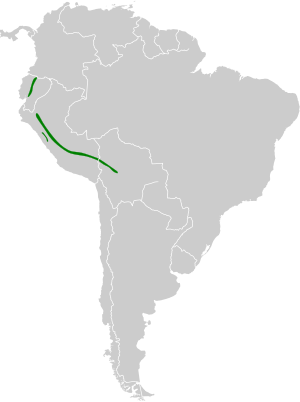Blue-mantled thornbill facts for kids
Quick facts for kids Blue-mantled thornbill |
|
|---|---|
 |
|
| Conservation status | |
| Scientific classification | |
| Genus: |
Chalcostigma
|
| Species: |
stanleyi
|
 |
|
The blue-mantled thornbill (Chalcostigma stanleyi) is a type of hummingbird. It belongs to a group of hummingbirds called "coquettes." You can find this bird in Bolivia, Ecuador, and Peru.
Contents
What is a Blue-Mantled Thornbill?
This hummingbird is known for its beautiful colors. It has a short, straight, black beak. Both male and female birds have a small white spot behind their eyes.
How Big Are They?
Blue-mantled thornbills are about 12 to 13 cm (4.7 to 5.1 in) long. That's about the length of a pen! Male birds weigh around 6.2 g (0.22 oz), which is lighter than a single grape. Females are a bit smaller, weighing about 4.5 g (0.16 oz).
What Do They Look Like?
Male blue-mantled thornbills are mostly dark sooty brown. Their head and neck feathers shine with a bronzy green color. Their back feathers look violet-blue. The feathers covering their tail are turquoise. Their tail is forked, like a "V" shape, and is steel blue.
They have a special patch of colorful feathers on their throat called a gorget. This gorget is emerald green on the chin and changes to pink, then purple-violet, or violet-blue at the bottom edge.
Female birds look similar to males. However, their gorget only has the green color under the chin. The outer feathers of their tail have pale tips. Young birds look a lot like the adult females.
Different Kinds of Blue-Mantled Thornbills
There are three main types, or subspecies, of the blue-mantled thornbill. They have slight differences in their colors:
- The first type, called C. s. stanleyi, has the colors described above.
- Another type, C. s. versigulare, has deep violet-blue colors all over its upper body, not just on its back. The pink to violet part of its gorget is also narrower.
- The third type, C. s. vulcani, is similar to versigulare. But the lower part of its gorget is blue-gray or gray-violet.
Where Do Blue-Mantled Thornbills Live?
These hummingbirds live in the Andes mountains. Each subspecies lives in slightly different areas:
- C. s. stanleyi is found on both sides of the Andes in Ecuador.
- C. s. versigulare lives on the eastern side of the Peruvian Andes.
- C. s. vulcani is found on the eastern Andes from southern Peru down to central Bolivia.
What Kind of Places Do They Like?
Blue-mantled thornbills prefer steep, rocky slopes. These areas often have humid grasslands called páramo and other plants known as jalca vegetation. They especially like areas with patches of Polylepis and Gynoxys trees.
They usually live at high elevations, between 3,000 and 4,200 m (9,800 and 13,800 ft) (about 9,800 to 13,800 feet) above sea level. Sometimes they are seen as low as 2,200 m (7,200 ft) or as high as 4,500 m (14,800 ft).
How Do Blue-Mantled Thornbills Behave?
Do They Move Around?
Blue-mantled thornbills sometimes fly to lower areas when the weather is very bad. Scientists think they might also move to different elevations depending on the season.
What Do They Eat?
These hummingbirds mostly drink nectar from small flowers. They like flowers from plants like Berberis, Gaultheria, Ribes, and Gentiana. They often protect the areas where they feed.
They also eat tiny insects. They have been seen picking insects from the underside of Gynoxys leaves. They also hop around on matted grass or rocks to find insects. Sometimes, they even catch insects while flying!
How Do They Have Babies?
Scientists believe that blue-mantled thornbills have their babies during the rainy season. Like most hummingbirds, the female bird takes care of the two white eggs by herself. Not much else is known about how they raise their young.
What Do They Sound Like?
The calls of the blue-mantled thornbill have been described in a few ways. One call is a "descending squeaky twitter followed by a mellower upslurred note." Another sounds like a "downslurred 'tseetsitsitsitsitr-whee-tsew'," with some variations.
Are They in Danger?
The IUCN (International Union for Conservation of Nature) says the blue-mantled thornbill is a species of "Least Concern." This means they are not currently in serious danger of disappearing.
They live in a large area, but we don't know exactly how many there are. Their numbers are thought to be going down. Even though they are generally common, their homes are being destroyed in some places. This happens when Polylepis woodlands are cut down or when natural grasslands are turned into pastures for animals.
See also
In Spanish: Colibrí de Stanley para niños
Images for kids




